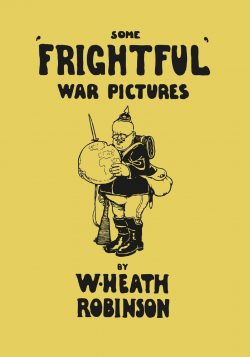

By W. Heath Robinson (Last Post Press)
ISBN: 978-1-4733-3483-0 (PB/Digital edition)
Not many people enter the language due to their own works and efforts. Fewer still last the course and remain relevant. Can you recall what “doing an Archer” means? We’ll soon be calling it “doing a Boris”… or “Truss” or “Sunak” or…
Moreover, when such endeavours also challenge egregious public perceptions and seek to correct outrageous out-of-control attitudes whenever governments seek to enflame the worst of humanity for immediate political gain – and yes I am drawing parallels with now – these heroes need to be remembered just as much as The Fallen of so many wars. On this day of all days, never forget that, and also please recall that all the dead we commemorate are only that way because politicians and diplomats on all sides of every conflict failed to do their jobs right and only cartoonists and satirists ever called them out for it…
William Heath Robinson was born on 31st May 1872 into an artistic dynasty. His father Thomas was chief staff artist for Penny Illustrated Paper and older brothers Thomas and Charles were also illustrators of note. After proper schooling, William tried – unsuccessfully – to become a watercolour landscape artist before turning to the family trade.
In 1902, he released fairy story Uncle Lubin before finding graphic work at The Tatler, Sketch, Strand, Bystander and London Opinion. During this period, he developed the humorous whimsy and penchant for eccentric over-engineered mechanical devices for simple tasks which made him a household name.
During The Great War, Heath Robinson uniquely avoided the jingoistic stance and fervour of many of his competitors, preferring to satirise the absurdity of conflict itself in every periodical venue and volumes of collected cartoons. When the shooting stopped, he went on to a career of phenomenal success and creativity in cartooning, illustration and advertising.
Sadly he found himself doing it all over again in World War Two…
William Heath Robinson died on 13th September 1944.
There was a mild resurgence of interest in his efforts some years ago (from whence stems this timely collection) and if you’re interested you could scour the internet or even real bookshops for Hunlikely! (1916) or The Saintly Hun: A Book of German Virtues (1917). More general joys and niggles can be seen in Flypapers (1919), Get On With It (1920), The Home Made Car (1921), Quaint and Selected Pictures (1922), Humours of Golf (1923) and Let’s Laugh (1939), and in larger compendia Heath Robinson At War (1941) and The Penguin Heath Robinson (1946)
His literary collaborations can be found in The Incredible Inventions Of Professor Branestawm – 1933, accompanying the novels of N Hunter – or in Mein Rant with R. F. Patterson (1940).
In the 1970s and 1980s Duckworth reprinted a selection of albums including Inventions, Devices, The Gentle Art of Advertising, Heath Robinson at War, Humours of Golf, How To Be A Motorist, How To Be A Perfect Husband, How To Live in a Flat, How To Make your Garden Grow, How To Run a Communal Home, How To Build a New World, and, ominously and rather perspicaciously foresightfully, How To Make the Best of Things…
Some of these may still be found at or ordered through your local Library Service. Both Ribaldry and Absurdities were reissued in the 1990s and were readily available online last month…
There is very little point of in-depth analysis in the limited space available here, but surely some degree of recommendation is permissible. In Absurdities (1934), Heath Robinson personally gathered his favourite works into a single volume that more than any other describes the frail resilience of the human condition in the Machine Age and particularly how the English used to deal with it all. They are also some of his funniest panels.
In Railway Ribaldry – a commission from The Great Western Railway Company to celebrate their centenary in1935 (and more power to them; can you imagine a modern company paying someone to make fun of them?) – he examined Homo Sapiens Albionensis, as steel and rails and steam and timetables gradually bored their way into the hearts and minds of us folk. Much too little of his charming and detailed illustrative wit is in print today, a situation that cries out for rectification more than any other injustice in the sadly neglected field of cartooning and Popular Arts.
I apologize for the laundry-list nature of the above, but I’m not sorry to have produced it and neither will you be when you find any the wonderful, whimsical, whacky work of William Heath Robinson, Wizard of Quondam Mechanics.
In the spirit of his unique contribution to war and peace, this review ostensibly concerns his first combat collection which is readily available in digital editions. Published in 1915, Some Frightful War Pictures reprinted gags and observations first published in The Sketch and The Illustrated Sporting and Dramatic News: assaulting both the despised and press-pilloried “Boche” and the Empire’s own inept High Command with genteel mockery.
In complex, convoluted cartons with titles like ‘The True Reason of the War (July 1914)’, ‘Nach Paris!’, ‘Hague Convention Defied!’, ‘Kolossal!’, ‘The War Lord at the Front!’ and ‘War Komforts!’, the artist repeatedly points out how alike all sides are, whilst subtly hinting that other ways of settling issues are always available…
© 2017 The Estate of William Heath Robinson.
